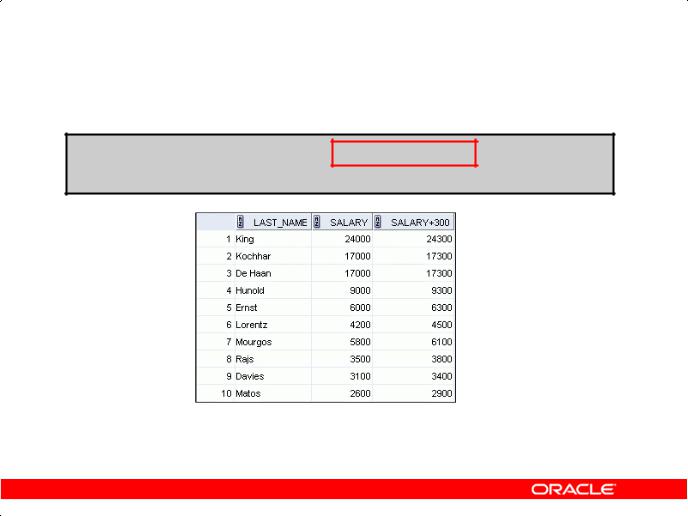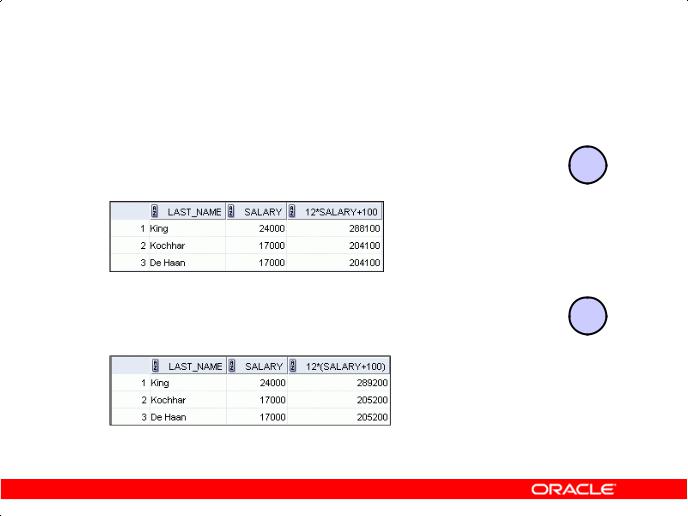
- •Preface
- •Introduction
- •Lesson Objectives
- •Lesson Agenda
- •Course Objectives
- •Course Agenda
- •Appendixes Used in the Course
- •Lesson Agenda
- •Oracle Database 11g: Focus Areas
- •Oracle Database 11g
- •Oracle Fusion Middleware
- •Oracle Enterprise Manager Grid Control 10g
- •Oracle BI Publisher
- •Lesson Agenda
- •Relational and Object Relational Database Management Systems
- •Data Storage on Different Media
- •Relational Database Concept
- •Definition of a Relational Database
- •Data Models
- •Entity Relationship Model
- •Relating Multiple Tables
- •Relational Database Terminology
- •Lesson Agenda
- •Using SQL to Query Your Database
- •SQL Statements
- •Development Environments for SQL
- •Lesson Agenda
- •The Human Resources (HR) Schema
- •Tables Used in the Course
- •Lesson Agenda
- •Oracle Database 11g Documentation
- •Additional Resources
- •Summary
- •Practice I: Overview
- •Objectives
- •Lesson Agenda
- •Capabilities of SQL SELECT Statements
- •Basic SELECT Statement
- •Selecting All Columns
- •Selecting Specific Columns
- •Writing SQL Statements
- •Column Heading Defaults
- •Lesson Agenda
- •Arithmetic Expressions
- •Using Arithmetic Operators
- •Operator Precedence
- •Defining a Null Value
- •Null Values in Arithmetic Expressions
- •Lesson Agenda
- •Defining a Column Alias
- •Using Column Aliases
- •Lesson Agenda
- •Concatenation Operator
- •Literal Character Strings
- •Using Literal Character Strings
- •Alternative Quote (q) Operator
- •Duplicate Rows
- •Lesson Agenda
- •Displaying the Table Structure
- •Using the DESCRIBE Command
- •Quiz
- •Summary
- •Practice 1: Overview
- •Objectives
- •Lesson Agenda
- •Limiting Rows Using a Selection
- •Limiting the Rows That Are Selected
- •Using the WHERE Clause
- •Character Strings and Dates
- •Comparison Operators
- •Using Comparison Operators
- •Range Conditions Using the BETWEEN Operator
- •Membership Condition Using the IN Operator
- •Pattern Matching Using the LIKE Operator
- •Combining Wildcard Characters
- •Using the NULL Conditions
- •Defining Conditions Using the Logical Operators
- •Using the AND Operator
- •Using the OR Operator
- •Using the NOT Operator
- •Lesson Agenda
- •Rules of Precedence
- •Lesson Agenda
- •Using the ORDER BY Clause
- •Sorting
- •Lesson Agenda
- •Substitution Variables
- •Using the Single-Ampersand Substitution Variable
- •Character and Date Values with Substitution Variables
- •Specifying Column Names, Expressions, and Text
- •Using the Double-Ampersand Substitution Variable
- •Lesson Agenda
- •Using the DEFINE Command
- •Using the VERIFY Command
- •Quiz
- •Summary
- •Practice 2: Overview
- •Objectives
- •Lesson Agenda
- •SQL Functions
- •Two Types of SQL Functions
- •Single-Row Functions
- •Lesson Agenda
- •Character Functions
- •Case-Conversion Functions
- •Using Case-Conversion Functions
- •Character-Manipulation Functions
- •Using the Character-Manipulation Functions
- •Lesson Agenda
- •Number Functions
- •Using the ROUND Function
- •Using the TRUNC Function
- •Using the MOD Function
- •Lesson Agenda
- •Working with Dates
- •RR Date Format
- •Using the SYSDATE Function
- •Arithmetic with Dates
- •Using Arithmetic Operators with Dates
- •Lesson Agenda
- •Date-Manipulation Functions
- •Using Date Functions
- •Using ROUND and TRUNC Functions with Dates
- •Quiz
- •Summary
- •Practice 3: Overview
- •Objectives
- •Lesson Agenda
- •Conversion Functions
- •Implicit Data Type Conversion
- •Explicit Data Type Conversion
- •Lesson Agenda
- •Using the TO_CHAR Function with Dates
- •Elements of the Date Format Model
- •Using the TO_CHAR Function with Dates
- •Using the TO_CHAR Function with Numbers
- •Using the TO_NUMBER and TO_DATE Functions
- •Using the TO_CHAR and TO_DATE Function with RR Date Format
- •Lesson Agenda
- •Nesting Functions
- •Lesson Agenda
- •General Functions
- •NVL Function
- •Using the NVL Function
- •Using the NVL2 Function
- •Using the NULLIF Function
- •Using the COALESCE Function
- •Lesson Agenda
- •Conditional Expressions
- •CASE Expression
- •Using the CASE Expression
- •DECODE Function
- •Using the DECODE Function
- •Quiz
- •Summary
- •Practice 4: Overview
- •Objectives
- •Lesson Agenda
- •What Are Group Functions?
- •Types of Group Functions
- •Group Functions: Syntax
- •Using the AVG and SUM Functions
- •Using the MIN and MAX Functions
- •Using the COUNT Function
- •Using the DISTINCT Keyword
- •Group Functions and Null Values
- •Lesson Agenda
- •Creating Groups of Data
- •Creating Groups of Data: GROUP BY Clause Syntax
- •Using the GROUP BY Clause
- •Grouping by More than One Column
- •Using the GROUP BY Clause on Multiple Columns
- •Illegal Queries Using Group Functions
- •Restricting Group Results
- •Restricting Group Results with the HAVING Clause
- •Using the HAVING Clause
- •Lesson Agenda
- •Nesting Group Functions
- •Quiz
- •Summary
- •Practice 5: Overview
- •Objectives
- •Lesson Agenda
- •Types of Joins
- •Joining Tables Using SQL:1999 Syntax
- •Qualifying Ambiguous Column Names
- •Lesson Agenda
- •Creating Natural Joins
- •Retrieving Records with Natural Joins
- •Creating Joins with the USING Clause
- •Joining Column Names
- •Retrieving Records with the USING Clause
- •Using Table Aliases with the USING Clause
- •Creating Joins with the ON Clause
- •Retrieving Records with the ON Clause
- •Creating Three-Way Joins with the ON Clause
- •Applying Additional Conditions to a Join
- •Lesson Agenda
- •Joining a Table to Itself
- •Self-Joins Using the ON Clause
- •Lesson Agenda
- •Nonequijoins
- •Retrieving Records with Nonequijoins
- •Lesson Agenda
- •INNER Versus OUTER Joins
- •LEFT OUTER JOIN
- •RIGHT OUTER JOIN
- •FULL OUTER JOIN
- •Lesson Agenda
- •Cartesian Products
- •Generating a Cartesian Product
- •Creating Cross Joins
- •Quiz
- •Summary
- •Practice 6: Overview
- •Objectives
- •Lesson Agenda
- •Using a Subquery to Solve a Problem
- •Subquery Syntax
- •Using a Subquery
- •Guidelines for Using Subqueries
- •Types of Subqueries
- •Lesson Agenda
- •Single-Row Subqueries
- •Executing Single-Row Subqueries
- •Using Group Functions in a Subquery
- •The HAVING Clause with Subqueries
- •What Is Wrong with This Statement?
- •No Rows Returned by the Inner Query
- •Lesson Agenda
- •Multiple-Row Subqueries
- •Lesson Agenda
- •Null Values in a Subquery
- •Quiz
- •Summary
- •Practice 7: Overview
- •Objectives
- •Lesson Agenda
- •Set Operators
- •Set Operator Guidelines
- •The Oracle Server and Set Operators
- •Lesson Agenda
- •Tables Used in This Lesson
- •Lesson Agenda
- •UNION Operator
- •Using the UNION Operator
- •UNION ALL Operator
- •Using the UNION ALL Operator
- •Lesson Agenda
- •INTERSECT Operator
- •Using the INTERSECT Operator
- •Lesson Agenda
- •MINUS Operator
- •Using the MINUS Operator
- •Lesson Agenda
- •Matching the SELECT Statements
- •Matching the SELECT Statement: Example
- •Lesson Agenda
- •Using the ORDER BY Clause in Set Operations
- •Quiz
- •Summary
- •Practice 8: Overview

Lesson Agenda
•Basic SELECT statement
•Arithmetic expressions and NULL values in the SELECT statement
•Column Aliases
•Use of concatenation operator, literal character strings, alternative quote operator, and the DISTINCT keyword
•DESCRIBE command
|
Copyright © 2009, Oracle. All rights reserved. |
Academy |
||
|
|
|||
|
|
Oracle |
||
& |
Only |
|
||
|
Internal |
|
|
|
|
Use |
|
||
Oracle |
|
|
|
|
Oracle Database 11g: SQL Fundamentals I 1 - 10

Arithmetic Expressions
Create expressions with number and date data by using arithmetic operators.
Operator |
Description |
|
|
+ |
Add |
- |
Subtract |
* |
Multiply |
/ |
Divide |
Academy You may need to modify the way in which data isOracledisplayed, or you may want to perform calculations, or look at what-if scenarios. All these are possible using arithmetic expressions. An
names, const nt numeric values, and the arithmetic
The slide lists the arithmetic operators that&are availableOnlyin SQL. You can use arithmetic operators in any clause of a SQLInternalstatement (except the FROM clause).
Note: With the DATE and TIMESTAMPUsedata typ s, you can use the addition and subtraction Oracle
Oracle Database 11g: SQL Fundamentals I 1 - 11

Using Arithmetic Operators
SELECT last_name, salary, salary + 300
FROM employees;
|
Copyright © 2009, Oracle. All rights reserved. |
Academy |
Using Arithmetic Operators |
|
|
The example in the slide uses the addition operator to calculate a salary increase of $300 for all |
||
employees. The slide also displays a SALARY+300 column in the output. |
||
Note that the resultant calculated column, SALARY+300, is not a new column in the EMPLOYEES
table; it is for display only. By default, the name of a new column comes from the calculation that |
||||
generated it—in this case, salary+300. |
Oracle |
|||
|
& |
|
||
Note: The Oracle server ignores blank spaces before and after the arithmetic operator. |
||||
Operator Precedence |
|
|
Only |
|
Use |
||||
|
||||
Internal |
|
|
||
If an arithmetic expression contains more than one operator, multiplication and division are evaluated first. If operators in an expr ssion are of the same priority, then evaluation is done from left to right.
You can use parentheses to force the expression that is enclosed by the parentheses to be evaluated
Oraclefirst.
Rules of Pre edence:
• Multiplication and division occur before addition and subtraction.
• Operators of the same priority are evaluated from left to right.
• Parentheses are used to override the default precedence or to clarify the statement.
Oracle Database 11g: SQL Fundamentals I 1 - 12

Operator Precedence
|
|
|
|
SELECT last_name, |
salary, |
12*salary+100 |
1 |
FROM employees; |
|
|
|
|
|
|
|
|
|
|
SELECT last_name, salary, |
12*(salary+100) |
2 |
|
||
FROM employees; |
|
|
|
|
|
Copyright © 2009, Oracle. All rights reserved. |
Academy |
Operator Precedence (continued) |
The first example in the slide displays the last name, salary, and annual compensation of employees. |
||
It calculates the annual compensation by multiplying the monthly salary with 12, plus a one-time |
||
bonus of $100. Note that multiplication is performed befo e ddition. |
||
Note: Use parentheses to reinforce the standard order of precedence and to improve clarity. For |
||
|
Oracle |
|
example, the expression in the slide can be written as (12*sa ary)+100 with no change in the |
||
result. |
& |
Only |
Using Parentheses |
|
|
|
|
|
You can override the rules of p ecedence by u ing parentheses to specify the desired order in which
the operators are to be ex cut d. |
Use |
|
|
Internal |
|
The second example in the slide displays the last name, salary, and annual compensation of employees. It calculates the annual compensation as follows: adding a monthly bonus of $100 to the
Oraclemonthly salary, and then multiplying that subtotal with 12. Because of the parentheses, addition takes priority over multiplication.
Oracle Database 11g: SQL Fundamentals I 1 - 13
